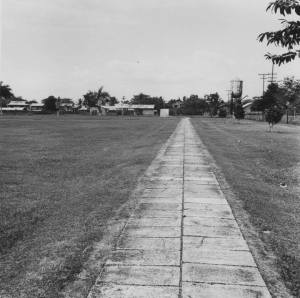
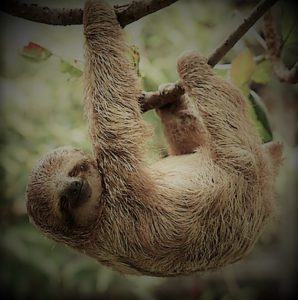 I missed the exciting life on the woodland farm but with the ‘untouched jungle’ so close to town I could still enjoy the pleasures of nature with weekend walks into the forest. Just looking out of a second-story window alone at the end of the general office building, and about 40 feet away, in a large tree on the border of the jungle, I could see a giant sloth. The animal spent several years there and was a rare sight with its slow movements and its upside-down posture and with much of its long fur covered with a growth of green algae. Just the sight of it effectively kept most of the town folk out of the forest!
I missed the exciting life on the woodland farm but with the ‘untouched jungle’ so close to town I could still enjoy the pleasures of nature with weekend walks into the forest. Just looking out of a second-story window alone at the end of the general office building, and about 40 feet away, in a large tree on the border of the jungle, I could see a giant sloth. The animal spent several years there and was a rare sight with its slow movements and its upside-down posture and with much of its long fur covered with a growth of green algae. Just the sight of it effectively kept most of the town folk out of the forest!
***If you missed the previous installments, click here: 1928: Part 1, 1928: Part 2, 1928: Part 3, 1928: Part 4, 1929:Part 5,
Bands of howler monkeys were heard and seen daily and, of course, great flocks of several species of parrots. The beautiful scarlet macaws, giving their raucous calls, were common sights flying over at dawn and at sunset. And I admired the hundreds of forest birds, the many flycatchers, ant-birds, hawks and the brightly-colored trogans, motmots and toucans as well as the brilliant butterflies.
All of the large animals, tapirs (dantos), “tigres”, mountain lions and bands of peccaries were close by and seen frequently by the few daring individuals who would venture into the jungle. But I was especially attracted to the great variety of orchids and the ease with which some, of them could be collected. That became one of my major hobbies during all the years we spent in the tropics. I commenced by sending a few dried specimens to the Director of the Summit Gardens in the Canal Zone requesting the favor of identification, and a source of literature for reference. The Director, who I did not know at the time, was Paul H. Allen and there will be more about him later.
I had played golf with my dad a few times at the Marshfield country club before leaving the States but was no pro by any means. KB Block was interested in golf so we both played the nine-hole course almost every day after work. Among other regular partners, or opponents, were Jerry Baron (the Port Superintendent), Slim Banack (railroad roadmaster), Casey Jones (a railroad conductor) Rudolf Jensen (the chief engineer for the division), Lane Evans (a farm district superintendent) and John Mase (chief draftsman). There was usually some heavy betting during the game – and afterward in the clubhouse as we rolled dice for drinks. I practiced a lot and became good enough to hold my own most of the time and win some money now and then.
I played golf several times a week for the remaining 11 years I lived in Panama. Mr. Block became a top-ranked golfer and participated in several professional tournaments in Central America during the next 30 years. The first tee was close to the office and the ninth hole was near the clubhouse. For us golfers, the game became a ritual – exercise, a chance to make a little money, and a way to get to the club and sit around rolling dice for the inexpensive (20-cent) Scotch highballs. Another golfer, Mike Reagan, the accountant, later told the story that it took him five years to discover that he could get to the club from the office by walking along a concrete path for four minutes instead of playing nine holes of golf!
The other guys in the accounting department, mostly Boston Irish and good at drinking, knew the short way from the start and never did take up golf. The dice games, with a box of five poker dice, were exciting – “chingona”, “Liars Dice”, “Beat It You Bastard”, etc., and time passed quickly until the final mess hall call for supper – sometimes later. I never could get interested in tennis – too hot!
The mess hall was operated for the company by a Chinese, Ling Yung, latinized to “Leon”, a smart and friendly person who also ran the bar for his own account. At Christmas he would give his “best customers” beautiful gifts of Chinese wines and an assortment of rare food delicacies. Everyone had credit and signed bar chits like there was no tomorrow, until payday arrived with no balance! Poor Leon, not the Company, would hold the bag for another month. He ran an excellent mess hall, having been in charge of an army mess in the Canal Zone before the Company hired him. The food was large helpings of American-style “meat and potatoes” but with “hot” Jalapeno peppers mixed in!
In the adjoining native village there was a pit for cockfights, a major Panamanian sport for young and old, rich and poor. A chance to win, or lose, a good rooster or a lot of Balboas and, sometimes, loose a little blood if you disagreed with another owner over how he tied the spur on his rooster!
The pool was popular with the married couples and their small children. The beach was a bluish black fine ‘volcanic sand from the Baru volcano and, with a 12 foot tide, was not suitable for bathing – a factor previously considered when the labor camps were constructed close to the ocean.
There were black-and-white movies in the clubhouse on Saturday nights, and dances on holidays, of which there were many between the American official ones and the Panamanian “Saints Days”. A special train made the circuit of all the farms to bring the “farmers” in and to take them home after the movies or dances. Performing the long and fast Panamanian dance, “La Pollera”, was really hot stuff with only a few ceiling fans which were not enough to cool down the exuberant dancers. Late one night, KB dragged a large washtub full of ice from the bar and, sitting in a chair in the middle of the hall, cooled his feet and legs in it while cooling his inner man with highballs for a couple of hours as the dancers circled around him.
In the native part of town, “across the railroad tracks”, an enterprising Panamanian built a large two-story motel type building, the “Miramar”, with a large bar and lounge and separate restaurant on the first floor and about a dozen rooms upstairs. Occasionally a salesman would rent a room for a couple of days but most were generally occupied by unattached young local native girls.
They were combination waitresses, saleswomen, and social companions who received a cut on all the drinks they sold to bar customers – mostly single male company employees from the accounting department and sailors whenever a ship was tied up at the wharf. At times the crowd would get a little boisterous and one night I happened to be there (I was not a regular) when the local Intendente sent his squad of six soldiers armed with loaded rifles to raid the place. They arrested all the men, mostly Company employees, for “disturbing the peace” and marched us to the calabozo, a large room in the combined Port Captain, Customs and Police building by the wharf. Previously Jerry Baron had introduced me to the Port Captain and the Intendente since I was practically the only gringo in town who could speak Spanish. So we were all seated in the Intendente’s office awaiting sentencing – each one giving his life history to the clerk who laboriously wrote it out in longhand.
All were to be fined five Balboas and spend a day in the clink. I was the last one called up and the Intendente winked at me and told the clerk in a stern, official voice, “libertad especial para el senor Marcos“. What a howl went up from behind the barred door as I walked out! However, I went directly to the office and had the night shift telephone operator call the local legal representative of the Company. So, about 2 hours later, around 4 in the morning, all the rest were set free and I became a hero!
The restaurant in the “Miramar Hotel” was a good one, operated by a Chinese, George Ng, who was the cook, and served excellent Chinese food. It was a popular place for company married employees to “eat out” and also with the bachelors who frequently enjoyed a change from Leon’s American-style hash in the Company mess hall.
Deep sea fishing was wonderful, out toward the Paridas Islands or off the peninsula to Charco Azul, where the coast became very rocky, and on to Burica Point and around it into the Golfo Dulce in Costa Rica. Catches of large papagallo, red snapper, spanish mackerel, kingfish, dolphin, rockfish, jack, tuna and many others were’ common. There were also sailfish and blue marlin. The Company had a large converted submarine chaser, the “Cricamola”, and a smaller launch used for tying vessels up at the wharf but they were not used for fishing, except for visiting top brass. However, Jerry Baron, who was also the official port pilot (with a captain’s license for “any vessel, any ocean”) would sometimes have to “tryout the engines” on the Cricamola and ask a few of us golfing pals to go along. We might just happen to drop a hand line with a trolling spoon over the side during the “trial run” which might take most of the day. Jerry’s wharf foreman, “Big Mac”, a Jamaican would also “tryout the bar” by serving ice cold Scotch highballs.
Johnny Mase, like me a naturalist at heart, often went along with me on woodland walks. He had been transferred from the Castilla division in Honduras where, almost for a song at an auction, he had acquired a 32-foot motor-sailor, a large sturdy wooden boat made in Denmark. It had been sailed across the Atlantic but its adventurous owners went broke in Panama and sold it off to get money to return to their homeland. On his first vacation, Mase went to Cristobal and sailed the “Whiskey II” through the canal and along the Pacific coast to Puerto Armuelles. I spent many hours helping him overhaul it, repair the engine, sailing gear and sails while it was “hauled out” for about a year. I eventually became a part owner and we had many wonderful experiences “sailing the Pacific” – details in a later chapter.
To be continued…
Stay tuned for PART 8 of this story: Life in Puerto Armuelles
NOTES:
*All photos, researched from the era, were added by the editor of Visit Puerto Armuelles.
*Golf photo courtesy of Fine Art America.
*The Tennis Court is still open today and is located behind the Las Palmas Elementary School. The public swimming Pool re-opened a few years ago. The Golf Course closed around 2012 or so and became overgrown. The bowling alley and clubhouse burned down several years ago.

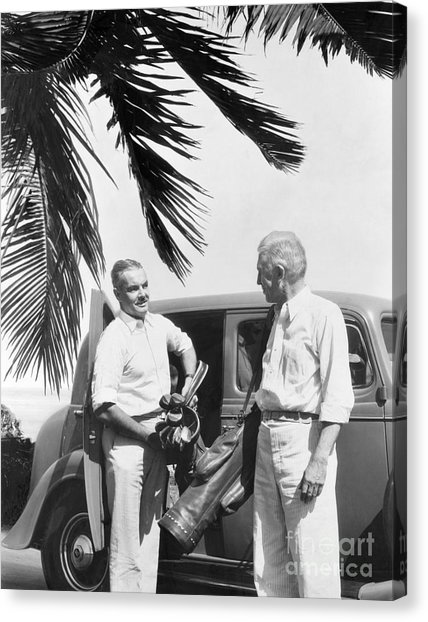
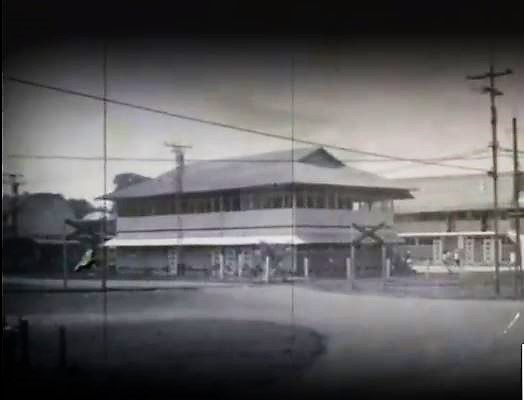
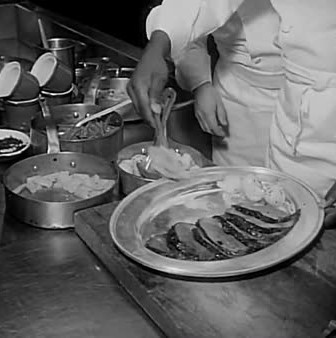
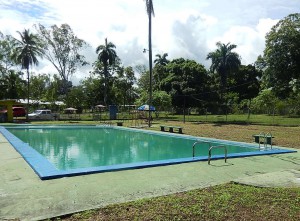
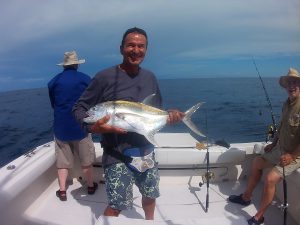
I missed the beginning chapterz!Is thereabook?
When you click on Part 7 (or any installment), there will be links at the beginning of the story to all of the past installments. These are an excerpt from a book and an autobiography of the author.